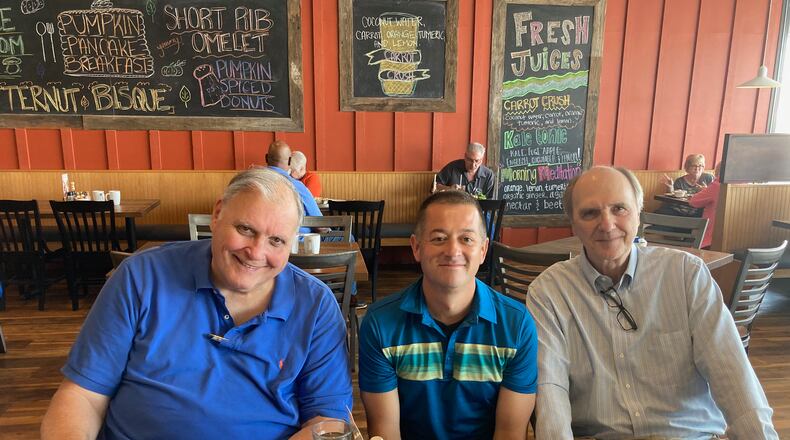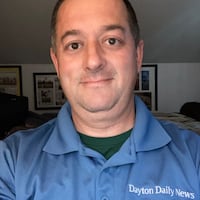As soon as I began to think of reasons to write the book — tentatively titled, “The Epicenter of College Basketball: A History of University of Dayton Arena” — I looked into what other similar facilities have books dedicated to them. The Pit, at New Mexico, Allen Fieldhouse, at Kansas, and Hinkle Fieldhouse, at Butler, all have books of varying lengths telling their histories. Multiple books about the Mecca of basketball, Madison Square Garden, have been written.
Putting the book in that company was one reason. A book about the arena just needs to exist, and I’ve written about it for nine seasons and talked to many of the most important figures in the arena history many times. I was about 7½ years away from being born when the arena opened in 1969, but my grandparents, Jim and Josie Leary, were season-ticket holders from the beginning and my parents, Jeff and Mary Jablonski, had their wedding reception at UD Arena. These were all reasons I thought I could be the person for this job.
There are plenty of other reasons the arena needs a book. It hosted more NCAA tournament games than any venue in the country. Michael Jordan and Lebron James have played at the arena. Barack Obama watched a First Four game while he was president. Elvis and Elton John and dozens of famous musicians and bands performed at the arena in its early decades.
Of course, the soul of the building, what truly makes it special, is the Flyer Faithful, who fill the place up every season no matter what the expectations are for the team. I took it as a good omen for my project that UD sold out the 2021-22 season before it began — something that had never happened. That will make a good final chapter along with the recent seasons that have seen Dayton achieve historic success on the way to 29 regular-season victories in 2019-20 and then Dayton experience something it has never seen with limited attendance during the pandemic in 2020-21.
In the last three months, I’ve sat down with a number of key figures involved in the arena’s history, from Dayton’s winningest coach, Don Donoher, to the leading scorers on the first team to play at the arena in 1969-70, George Janky and Ken May, to Gary McCans, the ticket manager for most of the arena’s history, plus a number of former players and UD’s current head coaches, Anthony Grant and Shauna Green, Dayton’s current coaches, who talked to me in their offices in September. Larry Hansgen, Bucky Bockhorn and Hal McCoy have talked to me. The list goes on.
Most of the interviews, I’ve started with a simple question: What makes the arena special to you?
Here’s a sampling of the responses:
Ted Kissell, former UD athletic director: “The No. 1 thing that made it stand out was the relationship of the fans to the building and to the program. The building would not have been built without the fans. The way that it was funded was through fees licenses. That was the core funding of the building — not corporate dollars or significant major gifts or university dollars.”
Tim Wabler, former UD athletic director: “The people who work here, all of them who have worked here over the years, they’re just so dedicated to the arena, making sure everything is in great shape. The day-to-day work that they put in, that’s what I remember.”
Neil Sullivan, current Dayton AD: “I think the arena is an outward reflection of our community, of our institution, of our basketball programs, of the people that played and coached before any of us were here. It’s our version of the chapel, and we view it as kind of a cornerstone of our brand. It’s a cornerstone of our identity. It’s not just bricks and mortar.”
Damon Goodwin, former Dayton guard: “To me, it was the tightness of the arena, how tight the fans were to the floor, and the old baskets. I still love the old baskets with the L-shaped pole and wires that went up to the ceiling. In today’s world, you don’t play in places that were built specifically for basketball enough, in my mind. I just think it was unique from that standpoint.”
Brooks Hall, former Dayton guard: “I’m from Troy, from a small gym that maybe held 1,000 people. I don’t remember, but it was a hot box. We broke fire codes every game. When I first walked into UD Arena for our first exhibition game, there were probably only 8,000 people there, but still in my mind, it felt like 30,000 because of the the acoustics and how loud it gets in there. It’s just a special place.”
Keith Waleskowski, former Dayton forward: “When you’re there in practice, and it’s empty, it’s a big, cavernous space and everything feels super far away. It feels gigantic. But then when you’re there and there’s 13,000 people and the lights are a little bit brighter and everybody’s screaming their heads off, it feels like everybody’s right on top down of you. It was fun to be the ones in the spotlight, down there playing. The whole city’s coming. The whole city’s watching. We’re just out there playing games, having fun and enjoying everybody getting as loud as they possibly can for a while.”
Scott DeBolt, current director of UD Arena: “The first time I ever came here was when I was in college. As a student at Wittenberg, I came over here for a basketball game. I was like, ‘Wow, this is cool.’ I had not been back until I interviewed for the job in 2013 and walked in the door. I was just blown away, and it’s that way every game day. Then you just sit there and think about the history and all the different events that have gone on here.”
Tim O’Connell, former director of UD Arena: “The building’s iconic for collegiate basketball with the Dayton Flyers and all the NCAA tournament games. It was just a really iconic place to work and highly respected within the the collegiate community.”
Bucky Bockhorn, former Flyer and longtime radio analyst: “Everything about the arena is nothing but first class. From a broadcaster standpoint, it is sensational because we’re on the floor. We’re in the action.”
Andy Farrell, special assistant to the head coach and recruiting coordinator at Dayton: “The special thing about the arena has always been the fans and the atmosphere. I’ve had the privilege of working in a lot of different conferences between the Big East and the ACC and multiple schools in the A-10 and have been to a lot of different venues, and nothing compares to UD arena. They were intentional in designing the arena so it feels like the fans are on top of you. There’s not a bad seat in the house. It is truly second to none. I think that’s what makes the UD brand so special.”
About the Author

